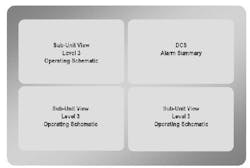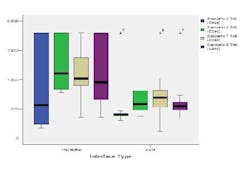Twenty-one professional operators at a world-scale North American ethylene plant site volunteered in 2004 to test their reactions to plant incidents using two distinctly different operator interface designs.
Ten operators used a traditional single-window style of display from an ethylene plant. Their performance was evaluated against 11 operators working on a multi-window style interface from another unit at the same site. The operators had several years of experience with their operator interfaces. The multi-window interface design was based on research by the Abnormal Situation Management (ASM) Consortium.
What were the results? While the two groups were of equivalent skill levels, and the simulated plant upsets they encountered were identical, the results were astoundingly different. The operators using the ASM-style interface out-performed their counterparts. The results make a strong case for improving the effectiveness of an often-neglected element in a chemical plant: the interaction between humans and control systems. Figures 1 and 2 compare the views available with different interfaces.
Figure 1 Operator forced to hunts for information
Figure 2: Managed process information available to operator
What is ASM?
ASM is both a practice and a set of supporting technologies. The Honeywell-led ASM Consortium is a research and development team comprising 12 chemical/refining companies, specialist service providers and universities addressing the complex human-system interactions that occur in chemical plants. The ASM Consortium strives to effectively use people and technology to change the way plants operate, moving from reactive control to proactive operations. It focuses on identifying and preventing problems facing industrial plant operators that can lead to major incidents such as fires and explosions.
The ASM Consortium received matching funds from the National Institute of Standards and Technologys (NIST) Advanced Technology Program in 1994 to improve the diagnostic tools used by operators. In the area of operator interface design, for example, the group set out to answer several questions: How can operators get early indication of process changes that could lead to problems and plant upsets? And which piece of equipment or process unit is the root cause of the problem?
The consortiums experience has led to the simple conclusion that sooner is better. Root-cause prevention is always preferred, but if a fault does occur, operators have a better chance to return the situation to normal if they quickly detect the fault. Its a basic principle that is very hard to keep in the volatile environments of chemical and refining plants, and it drives many of the projects the consortium has undertaken.
ASM vs. traditional
The consortiums philosophy is to match humans and technology as closely as possible. Research and development is being conducted in several areas, including alarm management, procedural operations, effective communications, training practices, early event detection, control room design and operator display design.
Procedural operations, for example, are important for achieving safe, reliable and profitable plant operation. Problems in this area - especially in start up and shut down are often cited as a critical component of many plant incidents. To help establish effective procedural management systems, the ASM Consortium has compiled a list of sound practices. The consortium is researching tools and techniques for better development, maintenance and use of document systems. One research project examined incidents at five manufacturing sites in North America to understand causes and impacts of procedural breakdowns. As part of this study, a risk-based classification system was defined to improve compliance in the use of procedures.
Another example of some of the ASM Consortiums work is found in control room designs where applying ASM principles means the consideration of console layouts, traffic flow patterns, sound abatement, lighting plans, building configuration, shift-worker fatigue countermeasures and many other critical aspects.
The 2004 interface study was developed from this prior work. Plant experts selected the scenarios for analysis from past incidents that occurred at the ethylene site. The scenarios were chosen so they could be evenly matched between the two plants and could be well represented on their respective high-fidelity training simulators. The first group of operators used a high-quality, traditional, operator display system where each of the eight screens in the simulator console used a single-window-per-screen approach, just like in the actual plant. The second group was asked to solve matching scenarios with the ASM-style interface, which duplicated their actual plant interface and was specifically designed to improve situational awareness and response to changing plant conditions. Each operator was presented with the selected set of operating scenarios and was evaluated on how much time it took to detect each event before receiving alarms, orient to or localize the problem and to solve the upset.
Telling results
The performance of the two groups clearly showed the value of the ASM interface:
Detecting the event before the first alarm: On average, operators using the ASM interface detected an event before an alarm 48% of the time traditional operators did so 10% of the time.
Total completion time: operators using the ASM-style interface took significantly less time to deal with the event as a group and were more consistent. ASM operators took an average of 10.6 minutes to complete the trials, as opposed to 18.1 minutes for the traditional operators a 41% improvement.
Successful completion of the scenario: On average, operators using the ASM interface successfully dealt with the situation 96% of the time. Operators using the traditional screen scored 70% on average representing a 26% improvement for the ASM interface group.
Presenting the results in a graphical format shows even more dramatically the difference in the performance of the two groups. In Figure 3, a clustered box plot of the Total Completion Time results, not only is the difference in the mean significant but the variability of the performance of the operators using the ASM interface was substantially smaller than the variability of the operators using the traditional interface.
Figure 3 - ASM interface allows faster response.
Using these results in an analysis designed to determine the average from a set of distributions of influencing variables also called a Monte Carlo simulation the study team assessed the impact on the plants operation. Historical incident records, in conjunction with the costs of the incidents were the other inputs to the simulation. The results showed the plant could save on the order of $800,000 per year by helping operators identify and react to plant problems with the ASM-style interface.
Elements of the ASM interface
The ASM-style displays used in the study are extensions of an earlier ASM display prototype called Abnormal Event and Guidance Information System (AEGIS). AEGIS was designed for scenario-based task analysis and was intended to improve the console operators situational awareness to changing plant conditions. The displays implemented in the study took it even further by integrating trends and provided access to additional online information, among other enhancements.
ASM interfaces are designed for proactive monitoring, which requires a big-picture awareness of the plant. Key features include integrated trends of information, multiple levels of increasing plant detail, and easy display navigation that is integrated with the process alarm management. This allows operators to see a broad picture of the process, but also gives rapid access to detailed information when necessary, in the context of the entire process.
Some of the key ASM features include:
- multi-windowing with controlled window management to minimize display overlays;
- multi-level, simultaneous views of increasing plant detail;
- yoked navigation between display levels (i.e., automated display invocation through pre-configured display associations for assisted, task-relevant navigation);
- tabbed navigation within a display level;
- integrated trending of historical information;
- integrated alarm management into graphics and navigation tabs
- right-mouse click access to online documentation;
- human factors graphics design (e.g., principled limited, color-coding of critical, changing information; limited 3-D objects; simple, effective symbols); and
- access to online information (e.g., alarm rationalization documentation, operating procedures, shift logbook, etc.)
The ASM-style interface presents process data in a way that better matches human cognitive abilities, making the data more valuable. For example, trends are continuously displayed to show critical-variable status over time, something that people are not good at estimating from memory based on snapshots of digital readouts. Color is selectively used to highlight dynamic information such as alarms and conditions that require an operators attention. Also, different levels of detail or a display hierarchy are simultaneously shown, which better matches the way people think about information when they are troubleshooting.
Future ASM work on proactive monitoring
The ASM Consortium currently is working to improve span of control overview displays. These screens allow operators to use pattern recognition to spot potential problems or process changes, without having to perform mental calculations to determine if the various values are deviating. These displays will monitor critical variables in the context of their limits and display visual indications of the operating envelopes (e.g., point value indicators and trends in the equipment graphics) as well as composite indicators or process and equipment health.
Another example is the consortiums research on early event detection techniques. Operators can take corrective actions without losing plant production by using advanced statistical methods to detect subtle changes in plant operation, often minutes or even hours ahead of any operator using traditional methods.
Many institutions devote their time to studying how to improve technological performance in chemical processing plants. However, given the significant production costs lost because of abnormal situations, value lies in working to improve human performance. Though these situations may be minor deviations that may never be reported to catastrophic incidents, their avoidance can translate into very powerful economic benefits.
We would like to extend our sincerest thanks to NOVA Chemicals for supporting and participating in the case study.





